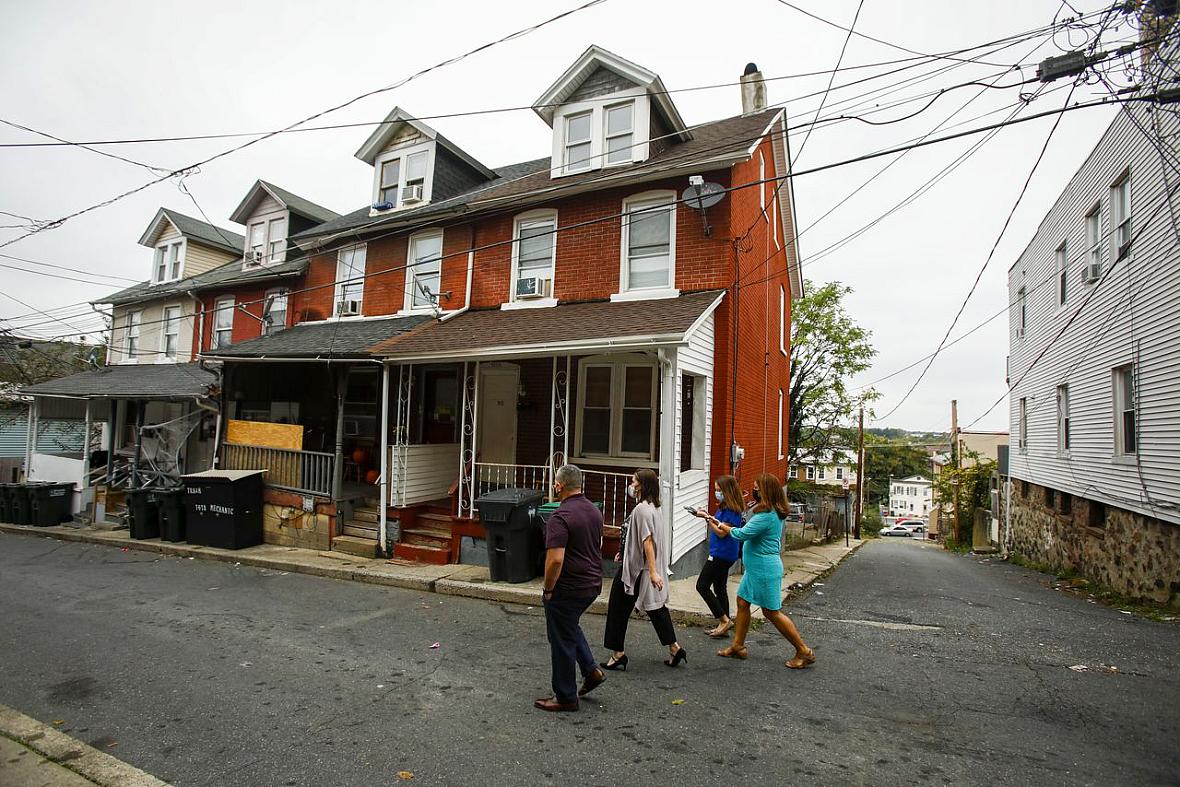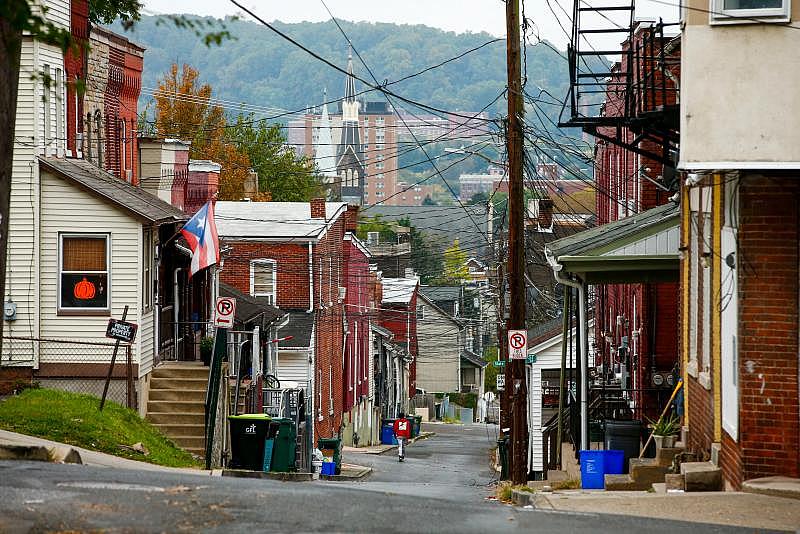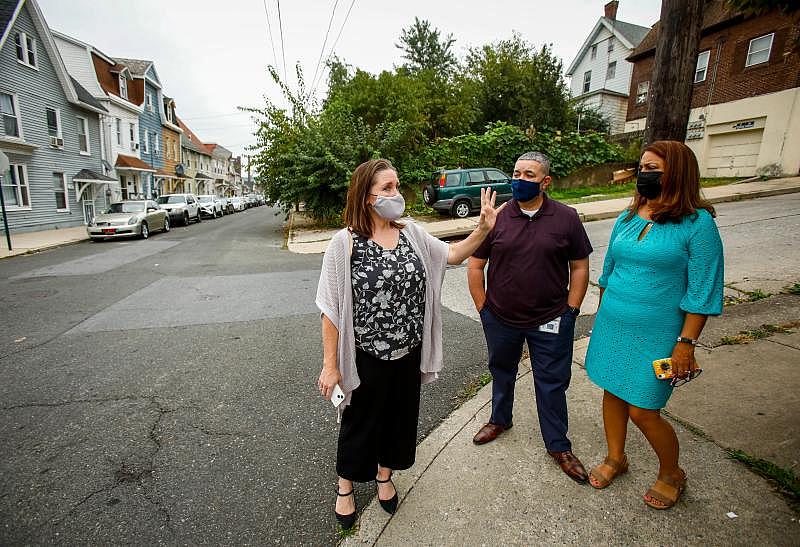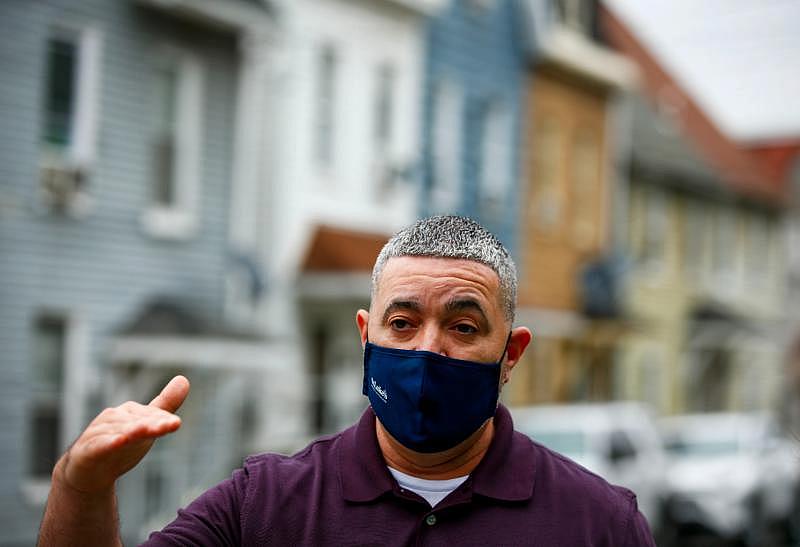The fallout when you’re Edged Out
This article was produced as part of a project for the USC Annenberg Center for Health Journalism’s 2021 National Fellowship.
Other stories by Sara Satullo include:
Are you a renter in Southside Bethlehem? We want to hear from you.
2 new projects slated to bring 95 new apartments to Bethlehem’s 4th St.
The fight for the heart of a South Bethlehem community
Will we recognize South Bethlehem after a real estate boom and pandemic? Introducing Edged Out.
Deal gives displaced South Bethlehem residents, businesses more time
Lehigh’s growth exposes a hard reality about South Bethlehem’s real estate market
South Bethlehem is a collage of cultures. Residents wonder if that can continue.
Bethlehem Southsiders show ‘striking’ love of community, optimism about future, forum report says

Donegan school officials report many families settle for housing that's not fit for habitation to stay in South Bethlehem.
Saed Hindash | For lehighvalleylive.com
Alicia Creazzo will never forget the day three children showed up on her doorstep at Broughal Middle School with their cat in a backpack.
They’d just been evicted from their South Bethlehem apartment despite a federal moratorium on evictions. The landlord forced the kids to vacate their home while their mother was working in a Lehigh Valley warehouse.
The resourceful trio swept up as many belongings as they could, including the family pet. With nowhere else to go, they walked to Broughal.
“I cried in my office,” said Creazzo, who’s been Broughal’s community schools coordinator for 11 years. “They had nowhere to go except for school.” She set the kids and cat in a school conference room while their mom finished her shift to avoid losing her job.
Even before the coronavirus pandemic, South Bethlehem families were struggling to pay rising rents brought on by a burgeoning real estate market that cut supply and drove up prices.
Keeping housing costs below 30% of income is a common benchmark of affordability. Across the school district, 3 in 10 households were paying more than that, with the greatest concentration in the Southside, a community where nearly 72% of homes are rentals.
Then the pandemic heated up the local real estate market, driving up sale prices and rents in an area where nearly one-third of residents live below the poverty level.
Only a handful of the more than 700 new apartments proposed or recently built in South Bethlehem are considered affordable. For months the eviction moratorium — now expired — meant little turnover of apartments and fierce competition for the limited empty units.
Finding a reasonably priced apartment became a daunting struggle in a community where the pandemic put one-third of residents at-risk of losing their jobs. To ease the strain and minimize disruption, a part-time housing advocate is working in the Bethlehem Area School District’s three Southside schools. The district is leveraging its existing community schools network to try to keep children in stable housing, which also keeps them in the same school and curriculum.
“Donegan (Elementary School) wants to have a kid enter kindergarten and take them all the way through fifth grade,” said Jack Silva, Bethlehem’s assistant superintendent.
Community advocates report an overwhelming level of need, limited staffing and too few options to house people. A mix of federal coronavirus relief funding and generous benefactors has meant an unprecedented level of money for rental assistance and new housing placements. But there just aren’t enough affordable rentals. Instead, the money is often used on extended-stay hotels.
“We’re using our funds most for homelessness prevention,” said J. Marc Rittle, executive director of New Bethany Ministries, a South Bethlehem-based nonprofit aimed at helping those who experience poverty, hunger and homelessness. “I can increase the staff and it is still not enough. Really what we need is for the flow (of evictions) to stop. We are really just working to keep our heads above water to get rental assistance out.”
The nonprofit went from serving 100 households a year to 1,000 between June 2020 and June 2021. New Bethany, which provides housing assistance to all residents living within the bounds of the Bethlehem school district, is on pace to exceed that this program year, Rittle said. Hispanic Center Lehigh Valley, a trusted resource for the Latino community, reports a similar spike in demand.
“Our community can no longer afford to live here,” said Victoria Montero, Hispanic Center executive director.
South Bethlehem's rental market is increasingly tight. Saed Hindash | For lehighvalleylive.com
Even before the pandemic, roughly 1 in 4 Lehigh Valley families were living paycheck to paycheck, often one small emergency away from financial ruin, according to a 2019 United Way report looking at the “Asset Limited, Income Constrained, Employed,” or ALICE, population. This income bracket encompasses working folks who make too much money to qualify for assistance, but too little to make ends meet. They struggle to find safe, affordable housing, work and pay for childcare.
“It (ALICE) is a measure of the stability of a community when you break it down,” said Erin Connelly, United Way associate vice president of community impact. “How do we have a thriving community when so many people are concerned about how they are going to pay their bills or afford medical care?”
The math doesn’t work
It took Aimee Marie Rush seven months to find a new apartment after she and her son were evicted in September 2020 so her new landlord could renovate the property, a legal loophole advocates say many landlords used to get tenants out during the federal moratorium.
During her search, there were often 50 to 100 applicants competing for the same apartment.
“Rental prices these days are insane, especially for a two-bedroom. You’re looking at least $1,300 a month,” said Rush, who is a vehicle title processor. “Minimum wage in Pennsylvania is $7.25. Do the math. It doesn’t work for a single person, let alone a single parent. The ends don’t meet the need.”
Like so many parents, the single mom spent months without childcare or familial help during the early days of the pandemic. Rush lives in constant fear her autistic son’s school will again close, making it impossible for her to work.
“It snowballed from there like it did for half of the world,” Rush said of her financial stress. “It was an impossible situation which eventually led to homelessness for me for six months with my son.”
Rush and her son found refuge at Third Street Alliance and then they moved to a hotel while she looked for an apartment. A rapid rehousing team helped her find a South Bethlehem apartment in the spring of 2021.
“Most of the apartments I saw were $1,300 to $1,400. I caught a deal at $1,050 for the house I am in,” said Rush, who just qualified for a housing voucher. “That is not bad. I remember when a two-bedroom apartment would run you $750.”
Not everyone is as lucky as Rush.
Donegan Elementary School staff walk on a block of Mechanic Street that is primarily owner-occupied. Saed Hindash | For lehighvalleylive.com
The majority of Southside residents are renters and they’re increasingly competing against one another for a shrinking pool of affordable housing. The economics of the student housing market mean it’s more lucrative for landlords to rent to college kids, who can pay $3,000 or $4,000 a month, than to families in a community with a median income around $40,000.
This rising demand for affordable housing means landlords have little incentive to bring properties up to code. Just before the pandemic, Bethlehem took a harder stance on code violations requiring all rentals to be licensed and inspected every three years. City officials were disturbed to see certain landlords are willing to pay fines rather than repair their properties. Previously, its code process was complaint-driven.
It’s a real worry for housing advocates and city officials as over 70% of Southside homes were built before 1970, with many needing extensive repairs.
“They still want to charge an arm and a leg,” said Luis Vasquez, Donegan Elementary School’s family development specialist.
Desperate renters are more willing to settle for substandard housing and often hesitate to demand repairs.
“I have been to houses where there are literally holes in the wall,” said Rosa Carides-Hof, Donegan’s community schools coordinator. “I have been in houses where they are infested with roaches, where I have been sitting at the table talking to mom and the roaches have been crawling all over the table. That is the type of environment that families are living in. Fumigation, a simple thing like that, it’s a battle to get the landlord to do.”
Donegan Principal Erin Martin-Medina and Luis Vasquez, school family development specialist, and Rosa Carides-Hof, community school coordinator discuss the many challenges their student's families have faced through the coronavirus pandemic. Saed Hindash | For lehighvalleylive.com
Today, advocates report the Southside deals with more out-of-town landlords who rely on Realtors to list their properties and require credit checks. And increasingly the landlords who do rent to traditional renters want three months’ rent at lease signing, another substantial barrier for a low-income person.
“The housing market is on the rise so landlords know they can get more,” said Creazzo, the Broughal community schools coordinator. “Apartments they’d typically rent for under $1,000, now that same one-bedroom is $1,500.”
That’s a heavy lift for many of the Southside families served by the school district. The majority of parents work in the Lehigh Valley’s booming warehouse industry, drawn to the demanding jobs by the high hourly pay and solid benefits. But it’s often not enough to keep up with the rising costs of rent, childcare, groceries and gas, advocates say.
“A lot of the economic pressures that some of our families are feeling in Bethlehem are not unique to our city,” Mayor J. William Reynolds said. “They are being seen across America, especially as we struggle to come out of the pandemic.”
The average warehouse worker in the Lehigh Valley made $43,851 in 2020, a figure that encompasses everything from stockers to managers, according to the most recent JobsEQ and Occupational Employment and Wage Statistics. Remember, the rule of thumb is that you shouldn’t spend more than 30% of your gross income on rent and utilities. So, the average Lehigh Valley warehouse worker can afford $1,096 in monthly housing costs. The pay drops even lower when you look at specific jobs: pickers and packers make $33,890 on average; forklift operators,$40,420.
It’s true that in recent months warehouses have advertised hefty sign-on bonuses and high hourly rates thanks to the pandemic-fueled boom in online shopping and labor shortage. Advocates, however, say they’re still seeing pandemic fallout and affordability gaps.
Many parents have been driven out of the workforce, unable to juggle school closures, mandatory quarantines and unreliable childcare with jobs that require in-person work. It creates a vicious financial cycle for families and instability for students.
“I am absolutely terrified of the same thing happening again,” said Rush, the single mom who lost her home. “I have no safety net. There is nothing I can do.”
The pandemic’s one upside is rental assistance funding to help folks make those landlord deposits. But that’s only if you can find a vacant apartment within your budget.
Janelle Deemer’s family of four has been living at The Candlewood Suites hotel since July 31 as they hunt for a new three-bedroom rental in Bethlehem. She’s looked at close to 100 units without success.
“Now the kids don’t want to leave the school district at all,” said Deemer, 34. “They are happy. They have friends. They are doing amazing in the school district but I can’t afford $2,000 to $2,500 a month.”
This is the second hotel they’ve been forced to make home after their West Easton landlord in April opted to not renew their lease and sold the property. The hotel room costs $833 a week, a bill that ate up the family’s entire income before New Bethany offered assistance.
“I felt useless,” Deemer said. “I couldn’t supply their clothes or do anything for them.”
Currently, New Bethany can offer a 90-day hotel voucher to Northampton County residents like Deemer to give them time to search for housing, Rittle said. The hope is that will prove to be enough time to place someone, but the reality of the market and staffing makes it tough, he said.
“We don’t do what we’d like to do as caseworkers,” he said. “We’d like to set a goal plan and meet with you weekly. That is the kind of thing we are unable to do.”
Donegan Community Schools Coordinator Rosa Carides-Hof helps families connect to any wraparound services they need. Saed Hindash | For lehighvalleylive.com
When she first fell behind on the hotel bill, Deemer worried that, if she asked school officials for help, they’d contact child welfare officials. Carides-Hof quickly quelled those fears, explaining a community school coordinator’s job is to help break down systemic barriers and connect families with help. The model is rooted in the idea that children need stability to effectively learn.
“If you are constantly moving you never get to stabilize,” Carides-Hof said. “You are always in this traumatic world.”
The community schools model strives to turn schools into neighborhood hubs that connect parents and students with resources from rental assistance to medical care. Locally, the United Way of the Greater Lehigh Valley acts as the intermediary, pairing schools with a lead and corporate partner. Lehigh University funds the Southside community school coordinators.
Those community schools have turned into lifelines for district families struggling with housing instability throughout the coronavirus pandemic. Things became so dire that part-time housing advocate Bria Dews was hired to help families find housing, navigate the mountain of paperwork needed to apply for aid and navigate landlord-tenant issues.
“It is very helpful to us because she is able to sit with the family and work through every question,” Creazzo said.
New Bethany was able to create the new job thanks to a donation from Bill Schaninger, a United Way board member with a passion for helping the Southside. It’s been so successful that Schaninger has agreed to fund the position for another year and the United Way is expanding the advocate program into new schools.
“The Bethlehem Area School District community schools have been a beacon of hope during this time, helping to coordinate services and get families the assistance they needed,” Dews said.
But the schools can’t perform miracles or build more affordable housing.
“I am at a bit of a gridlock with the availability of housing,” Dews said. “It is almost like an emergency room. I am triaging.”
Househunting feels like a full-time job for Deemer. She’s fueled by her desire to give her daughter, 12, and son, 11, their own rooms and get their belongings out of storage. Even when she does find the elusive affordable home, she has an eviction on her record to overcome in a tight market, a remnant of a time when she says she was less financially responsible.
“It’s been a rollercoaster. There’s times I think, is there anything out there? Is there a way to make it happen?” Deemer said. “Deep down I express to myself, how do I get this done? Do I rent? Do I buy? If I went somewhere else, I am leaving my (familial) support system. My kids lose their schools. I’m left with a lot of not-good choices.”
School often slips from the top of a family’s priorities when they have nowhere to sleep at night, said Beth Tomlinson, United Way director of education.
Donegan Elementary School Principal Erin Martin-Medina on Mechanic Street with Luis Vasquez, family development specialist. Saed Hindash | For lehighvalleylive.com
“It creates so much disruption in a child’s life,” said Erin Martin-Medina, Donegan’s principal. “I think a lot of people don’t understand it because they haven’t lived it.”
But research shows that positive childhood experiences can buffer the adversity many children face, the United Way’s Tomlinson said. Things like strong friendships, a sense of belonging in school and adult mentors all can temper the trauma a pandemic and housing instability can bring long into a child’s adulthood, Tomlinson said.
Deemer’s witnessed what a sense of belonging has done for her daughter, who for the first time in her life has a strong friend network at East Hills Middle School.
“She made the honor roll,” Deemer said. “This school really is phenomenal.”
Small-time to big time
Cantelmi’s Hardware store owner Rick Cantelmi is one of the small-time landlords who still rents to low-income folks. One of his one-bedroom units with parking costs $650 a month. His leases don’t include automatic bumps and he often lets tenants make two payments a month.
“I have a lot of tenants that can’t afford a rent increase,” Cantelmi said, noting when taxes or insurance go up he must pass on those costs. “Frankly, I don’t need the money … I like to give back to the community.”
Cantelmi notes a key difference between him and some other landlords: “I’m a hardware store owner who has apartments,” he said, not someone with 200 units. He acquired most of his rentals with an eye to bolstering the blocks around his nearly 100-year-old family business at 521-529 E. 4th St. He selects his commercial tenants — they currently include a beauty salon, shoe store, yoga studio, business incubator and clothing store — carefully.
“I am trying to make it a neighborhood for life (like all of South Bethlehem once was),” Cantelmi said.
South Bethlehem used to have many local landlords like Cantelmi who relied on word-of-mouth to rent their properties. Some didn’t even draw up official leases, a practice that leaves tenants quite vulnerable.
Luis Vasquez, family development specialist at Donegan Elementary School, talks about the housing market in South Bethlehem. Saed Hindash | For lehighvalleylive.com
Today, there are more out-of-town investors and the high-quality units get rented to students, not locals, Vasquez, the Donegan family development specialist, said. He’s worried soon South Bethlehem will be 80% student rentals. He’s watched affordable units get sold and rents skyrocketed, displacing Donegan families.
“It is changing the fabric of our community,” Vasquez, who himself was priced out from the Southside, said. “They want to get rich overnight regardless of the damage they do to people.”
In today’s real estate market finding an apartment is so often about knowing the right person.
Gloria Rodriguez was left homeless after a Thanksgiving Eve fire destroyed her Southside rowhome. The mother of six praises God that none of her children or grandchildren were visiting when the fire broke out, Rodriguez said through a translator. She was bolstered by the outpouring of community donations but worried about finding a place to live after years of housing instability.
Then her church community connected her to a landlord who was so moved by her story he did not sell his State Street rental as planned, Rodriguez said. She is paying $925 a month for the “beautiful” apartment.
“This is not the norm,” Carides-Hof emphasized. “She has been blessed. I think it is her faith.”
Once the reality of the fire set in, Rodriguez started worrying about housing as her Red Cross gift card only covered two nights in a hotel. She already intimately knew the struggle to find affordable housing for a big family on a tight income.
When she moved to Itaska Street from Reading a decade ago, Rodriguez easily found a four-bedroom home for $850 a month. A few years later, she was paying $1,100 a month for a studio on Itaska, rent that drove her to Easton temporarily.
She returned to Bethlehem about two years ago when Realtor Lucy Ramos found her the three-bedroom East Third Street home. Rodriguez could afford the $1,100 a month rent, but the house had plenty of problems. A small fire broke out in the attic two months before the blaze that destroyed her home, she said.
The cause of the blaze remains under investigation, according to Bethlehem Fire Marshal Craig Baer.
The other displaced family has not been as lucky, Carides-Hof reports. They are living with relatives, squeezing at least eight people into one home.
“I wish there could be emergency affordable housing for people faced with this type of situation,” Rodriguez said through a translator. “There are people out there living in their cars or they’re homeless because they fear Children and Youth getting involved … There is a lack of shelters for families.”
How do we solve this?
The coronavirus pandemic and the Lehigh Valley’s soaring real estate market have exacerbated the region’s affordable housing crisis, but also intensified efforts to solve it.
Affordable housing is now a constant topic in Bethlehem City Hall. The city just completed New York University’s Furman Center Housing Solution Labs housing workshop to help the city develop and execute a comprehensive local housing plan. The new mayor is making the city’s affordable housing task force a permanent entity.
Reynolds emphasizes there is no simple solution. Pennsylvania’s planning laws provide local governments with a lot of carrots, but few hammers to promote affordable housing. And new developments of affordable housing can take many years to go from blueprint to ribbon-cutting due to the lengthy tax credit process. The best strategies require local governments, nonprofits and the private market working in concert, Reynolds said.
“No one institution has the power to drastically alter your housing market,” he said.
City leaders realize that the influx of federal coronavirus relief into all levels of government presents once-in-a-generation opportunities to make meaningful change. Bethlehem is studying the creation of a homeless shelter to meet the needs of all populations from families to LGBTQ folks to those served by the volunteer-run cold-weather emergency shelter.
But studies and new buildings take time. That’s time someone like Janelle Deemer doesn’t have. She wants to move her family out of a hotel now.
To boost the pool of affordable housing, nonprofits are getting creative in hopes of more readily connecting potential tenants with landlords willing to rent to them.
The Lehigh Valley Regional Housing Advisory Board is building a regional database to track available units and offering incentives to landlords like signing bonuses, guaranteed rent and mitigation funds if a unit is damaged.
“This is a real effort to look at this on a regional scale,” said Connelly, the United Way associate vice president of community impact. “Can we build a strong network of landlords who feel proud to be part of an effort like this?”
New Bethany Ministries’ Rittle says the goal is to break through landlord trepidation about renting to low-income people by showing them it can actually be a stable, guaranteed source of income.
“If you choose to open up more slots and spaces for low-income families, it is not random, cross your fingers and hope they are a good tenant,” Rittle said. “It will be a good tenant because they are being case managed.”
The nonprofit has succeeded in building its own network to about 25 landlords.
“Oftentime property owners do care about their clients, but they also have to make money,” Rittle said. “This is not an us against them issue.”
At Donegan, Vasquez and Carides-Hof would love to see the city team up with landlords to fix up aging rentals in exchange for charging affordable rents. Bethlehem is weighing a rental rehab program to get aging housing stock updated while keeping it low-income housing.
It’s clear there is no silver bullet. Solving the crisis requires a coordinated regional and state-level response.
“Given the climate in the state Legislature right now, I don’t see that happening,” said Alisa Baratta, executive director of Easton’s Third Street Alliance and the co-chair of the Lehigh Valley Regional Homeless and Advisory Board. “I wish I had a more positive outlook on this, but I think it is a challenge we are going to be looking at for a long time.”
Our journalism needs your support. Please subscribe today to lehighvalleylive.com.
Sara K. Satullo reported this story while participating in the USC Annenberg Center for Health Journalism’s 2021 National Fellowship, which provided training, mentoring, and funding to support this project. She may be reached at ssatullo@lehighvalleylive.com.
[This article was originally published by Lehigh Valley Live.]

